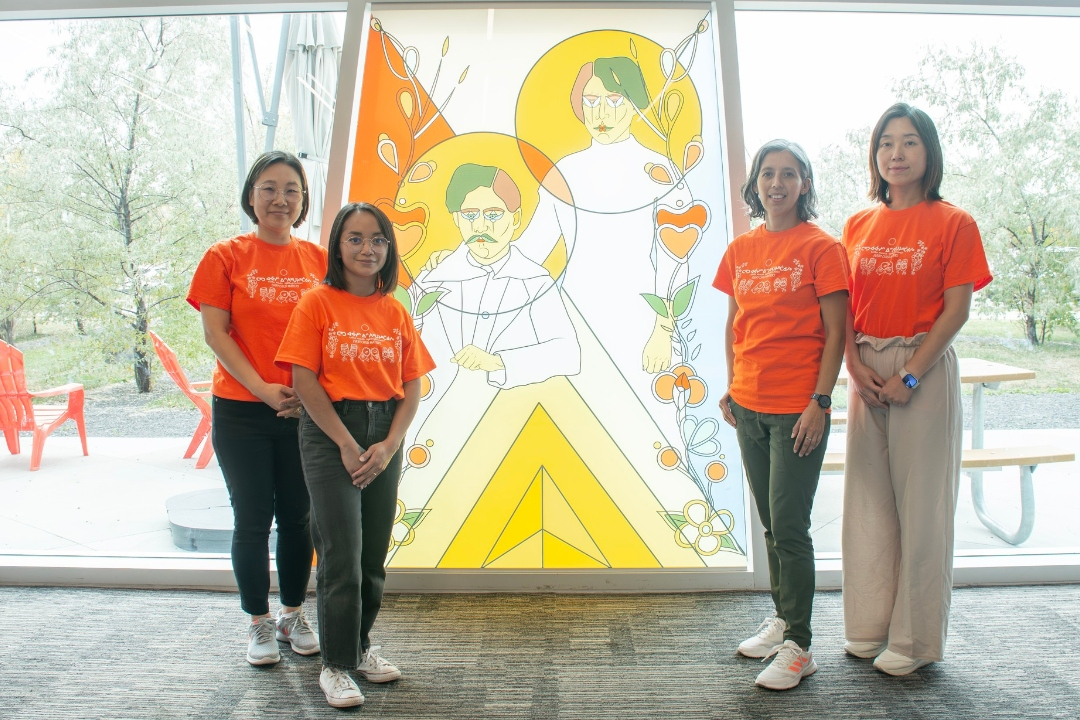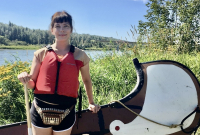Support strong Canadian climate journalism for 2025
Warning: This story may be traumatizing for some readers.
The metal buffalo at Calgary’s Central Library is hard to miss.
Its body is made up of hundreds of letters strung together to form 120 words in the language of the Blackfoot Confederacy. The statue, called Education is the New Buffalo, stands about shoulder height, if not a bit taller than its creator Lionel Peyachew.
The sculpture is a response to an open call made by the library for work by Indigenous artists. Peyachew is a member of the Red Pheasant Cree Nation in Saskatchewan and an associate professor of Indigenous fine arts at First Nations University of Canada. He said the sculpture represents how Indigenous Peoples’ way of life has changed.
“A long time ago, we were all dependent on the buffalo. That was how we survived,” Peyachew said. “But now, all new survival is education.”
The Calgary Public Library is one of dozens in urban centres across Canada prioritizing Indigenous representation in their space. New developments, such as the Ādisōke facility in Ottawa and the Dawes Road branch in Toronto, are being built to feature permanent installations of Indigenous art and Indigenous-led building design.
In 2017, the Canadian Federation of Library Associations released its own report in response to the Truth and Reconciliation Commission’s 94 calls to action in 2015. The association crafted 10 recommendations specific to libraries that have since been endorsed by 38 library organizations across Canada. Those included implementing Indigenous knowledge protection protocols and enhancing opportunities for Indigenous library, archival and information professionals.
Kirk MacLeod, chair of the association’s Indigenous matters committee, said a followup document will aim to inspire further action by focusing on the current accomplishments of Canadian libraries.
Peyachew is among 11 Indigenous artists with permanent installations scattered throughout the Calgary library in the heart of downtown. For Peyachew, as an Indigenous person, the location is an invaluable part of why this piece matters.
“Our work was always in such places as the museum, where everything was old and just shown for curiosity,” he said. “Now, we are able to show our art inside a public space, which means a lot to me.”

Danielle Piper had a patchwork of people wander into her gallery while she was Indigenous artist-in-residence at Calgary’s Central Library. She said teachers often ask her how to responsibly teach Indigenous art in their classrooms, but there was one visitor in particular who still sticks with her.
“There was one man I remember who had just left incarceration and he was looking for medicine,” she said. “So I gave him smudge (and) we started a conversation.”
It was an emotional exchange like this one about art as a way to heal and release trauma that Piper thinks she would not have if she wasn’t present in this public, urban space.
“That was really a beautiful exchange to have with people,” she said.
After her time at the library, Piper became a full-time artist and has continued to work with the library on a number of art projects. She encourages others to apply for her former position because she wants Indigenous artists to continue taking up space.
“It's important that we claim a bit of that Indigenous space and occupy it,” she said. “Put someone in it who’s working and even just available as a way of making that space more inviting to other Indigenous people.”
Kelli Morning Bull, a member of the Piikani Nation in southern Alberta and Indigenous design lead for the Calgary Public Library, said one of the initiatives she’s most proud of is the Elders’ Guidance Circle program, which began in 2019.
Individuals or groups can submit requests to meet with an elder or knowledge keeper from the Treaty 7 and Calgary area. Those requests are vetted by a co-ordinator and, if approved, handed off to an elder. Morning Bull said requests for the program skyrocketed in 2021 after the remains of 215 children were found at the site of a former residential school in Kamloops, B.C.
Now, people are booking a month in advance to connect with an elder due to the sustained volume of requests, and positive testimonials continue to pour in.
“Their minds are blown because of the amount of information they didn't learn in school, or the perceptions and biases they've had around Indigenous culture and Indigenous people,” she said.
“It's really shifting … how people are viewing Indigenous people and it’s building compassion.”
While Calgary now has a few years of experience making its spaces welcoming for urban Indigenous people, similar projects in other major cities across Canada are just taking off.
In Ottawa, a celebration held in October marked the construction of five floors at Ādisōke, a new facility created through a partnership between the Ottawa Public Library, Library and Archives Canada and the Anishinābe Algonquin Nation — whose unceded, traditional territory hosts the building. Ādisōke means “storytelling” in Anishinābemowin Algonquin language.
Set to open in 2026, the space promises a circular lodge designed to represent a traditional wigwam on the second floor, a wayfinding wheel at one of its entrances, an interior atrium with wood elements, some oral storytelling stations and a garden filled with native trees and plants of significance to local First Nations.
Dawn Saunders Dahl, a member of the Métis Nation of Alberta and curator of Indigenous public art for Ādisōke, said in addition to the facility’s structural elements, she wants the space to showcase Indigenous art from across Canada.
“The real intent is to ensure that everyone, but especially Indigenous artists, feels like this is a place for them to feel welcome and see something of their culture reflected in those spaces,” she said.
Peyachew said the more libraries in Canada that decide to integrate Indigenous knowledge and public art, the more Indigenous artists will be able to see a future for their work.
“It (shows) other young artists that you have potential to show your art in public spaces,” Peyachew said. “Do not give up. You're an artist. You're an Indigenous artist. You're special.”
If you are a residential school survivor and need emotional support, a national crisis line is available 24 hours a day, seven days a week: 1-866-925-4419






Comments